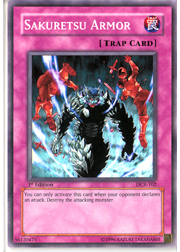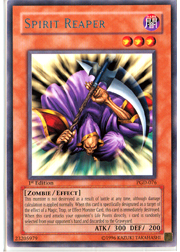Let’s face it, folks. Spirit Reaper has been defining the Advanced format for the past six months, and it’s looking like it will influence player’s choices for the next six months as well. It’s a fantastic monster that can act as either a nearly impenetrable wall or a nasty weapon against your opponent’s hand. Usually, it’ll play both roles throughout the game, acting as a shield for you until you can draw the right cards to wipe out your opponent’s field. At that point, you can turn Spirit Reaper into a sword and start to slash away at whatever options your opponent may have left. Spirit Reaper’s effect can be catastrophic, as it deprives your opponent of options and forces him to her to resort to topdecking.
In an effort to halt this type of Spirit Reaper abuse, many players immediately began running more 1-for-1 removal effects as a method of dealing with attacking monsters during the opponent’s battle phase. Sakuretsu Armor is probably the most well-known of these 1-for-1 cards. However, what is Sakuretsu Armor, exactly? We know it’s a card that’s everywhere, and it’s one of those trap cards that almost every player is wary of when they’re making their attacks. But what’s the real intention behind Sakuretsu Armor? What makes it so feared and such a concern in this format? When is it a completely dead draw? There’s more to a reactive trap card than simply setting it and springing it on the first monster you see.
Breakdown and Strategies
Sakuretsu Armor can only be activated when one of your opponent’s monsters attacks you. This trap card will destroy that attacking monster. This effect is simple enough, right?
 The conditions under which you can use Sakuretsu Armor fall upon whether or not your opponent declares an attack. This limits Sakuretsu Armor as a weapon to aggression that you can use to stop any attacking monster. You are given some freedom in whether or not you activate your trap card in response to your opponent’s first attack declaration or to a later attack. The level of control that you have over your own traps can cause your opponent to wonder about what cards you might have face down on your side of the field. This is one of the many advantages of reactive trap cards, as they not only counter your opponent’s actions, but they also force your opponent to reconsider all of his or her actions that would normally be easy to take.
The conditions under which you can use Sakuretsu Armor fall upon whether or not your opponent declares an attack. This limits Sakuretsu Armor as a weapon to aggression that you can use to stop any attacking monster. You are given some freedom in whether or not you activate your trap card in response to your opponent’s first attack declaration or to a later attack. The level of control that you have over your own traps can cause your opponent to wonder about what cards you might have face down on your side of the field. This is one of the many advantages of reactive trap cards, as they not only counter your opponent’s actions, but they also force your opponent to reconsider all of his or her actions that would normally be easy to take.
However, the problem lies with the fact that you can only mess with your opponent’s head if he or she actually plans to declare attacks. The evasion of combat has been one of my greatest points of emphasis while dueling in the past six months. My focus on this tactic started with a more burn-oriented deck that used Lava Golems and Ojama Trios, and this deck eventually became my mono-burn control deck. You probably recall this one from a few months back, but a little review can’t hurt.
Sakuretsu Armor is one of the best reactive cards in the game. I love it, and I’ve always used three copies of it in every deck that focuses on some sort of monster destruction for its control. However, one of the reasons why anti-attacking decks are so potent in this format is because practically everybody expects to see multiple copies of Sakuretsu Armor in each opponent’s deck. This card has single-handedly set a standard of what to expect in a tournament, and this gives you the ability to prepare accordingly.
Of course, most duelists still run decks that require a lot of attacking. This is fine if you plan ahead and either use monsters that are affected less by Sakuretsu Armor, or you run enough spell and trap removal to compensate. One of my favorite ideas behind Sakuretsu Armor and Widespread Ruin was to run three copies of Des Lacooda and Masked Sorcerer. Your trap cards can counter all of your opponent’s attacks, your little monsters bury your opponent in a landslide of card disadvantage, and you can maintain a strong overall card presence.
 Of course, since card presence isn’t the only factor in a game, the overall deck concept occasionally fell to pieces, simply because the deck could be too slow or too unstable if the opponent is too aggressive, too quickly. Unfortunately, this is the ultimate issue for most decks that run multiple copies of Sakuretsu Armor—fast aggro decks are a bit of a pain to deal with. If the opponent has too many aggressive monsters, the player with the Sakuretsu Armors will inevitably get smashed (unless, of course, that player is also defending with Spirit Reaper).
Of course, since card presence isn’t the only factor in a game, the overall deck concept occasionally fell to pieces, simply because the deck could be too slow or too unstable if the opponent is too aggressive, too quickly. Unfortunately, this is the ultimate issue for most decks that run multiple copies of Sakuretsu Armor—fast aggro decks are a bit of a pain to deal with. If the opponent has too many aggressive monsters, the player with the Sakuretsu Armors will inevitably get smashed (unless, of course, that player is also defending with Spirit Reaper).
Sakuretsu Armor acts primarily as a solid card for control decks. Aggro decks will find it far too slow, as most aggro decks can earn their card advantage through simply beating the stuffing out of other monsters. On the other hand, control decks need cards that can allow its players to stabilize for a surefire win. Sakuretsu Armor acts as one of the available stabilizer cards for a control player to use in order to slow the game down to the desired tempo. Other stabilizers, like Widespread Ruin, also assist control players in reaching a desired late-game state, but Sakuretsu Armor is one of the most solid tempo cards available. While it doesn’t have quite as much raw power as Level Limit – Area B, Sakuretsu Armor removes threats from the field instead of just locking them down. This is one of the reasons why many veterans push Sakuretsu Armor as such an important card. Granted, it’s sometimes pushed a little more than it needs to be, but Sakuretsu Armor is undeniably good.
When using Sakuretsu Armor, be wary of whether your opponent is even going to attack during your match. If you suspect that your opponents are playing for a different win condition, then your Sakuretsu Armors will turn out to be nothing more than blank cards. Be sure to side them out immediately, as keeping cards in your main deck that serve no purpose in a match isn’t a good way to use your side deck effectively.
Final Thoughts
Sakuretsu Armor is one of those cards that you’re just going to have to deal with. The looming presence of Spirit Reaper in both this and the previous format have made reactive traps that destroy monsters a useful inclusion for almost any deck. Keep in mind, though, that you can also use this incredible hype of Sakuretsu Armor to your advantage. I’ve made numerous hints on how to play around the national metagame and its glorification of Sakuretsu Armor in many of my previous articles, so be sure to read some of my old material for ideas on what to run in today’s metagame. This is the actual reason why I looked at Sakuretsu Armor today, as its popular use required that it be analyzed a little deeper.
Reflecting upon a popular card can give you the tools with which to fight it. You can probably assume that most players using Sakuretsu Armor are slower control players. Fast aggression or all-out abandoning of the battle phase are good methods of making these matchups easier for you. I feel that avoiding the battle phase is probably one of your best strategies, but if you’re an aggro player, remember not to rush recklessly into your opponent’s Sakuretsu Armors. You need to have the ability to regain the tempo that is lost when your monster is destroyed, some extra monsters to make sure you can continue to press for attacks, or the ability to quickly destroy or negate your opponent’s trap cards. Any one of these tactics will be your best approach against most of the decks in this environment. If anything, remember that Sakuretsu Armor is a very efficient reactive card, and you’re sure to see it in almost every tournament.
If you have any questions or comments regarding this or previous articles of mine, feel free to email me at Mrosenberg at Metagame dot Com. I will do my best to get back to all emails.